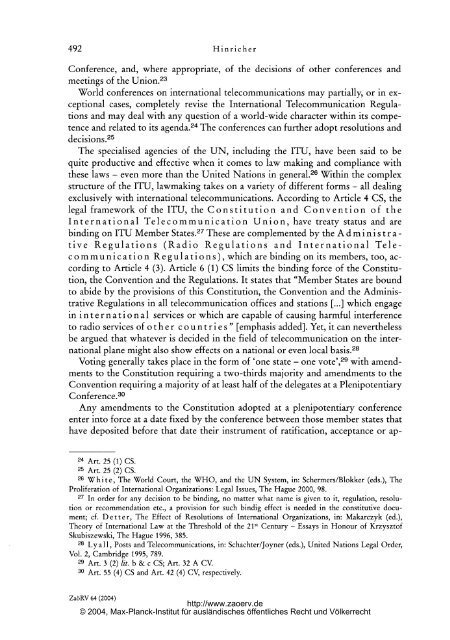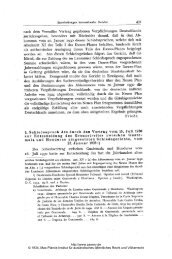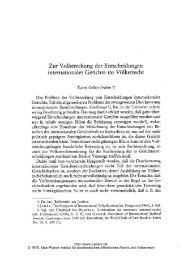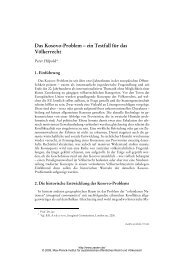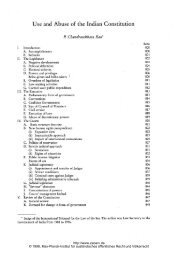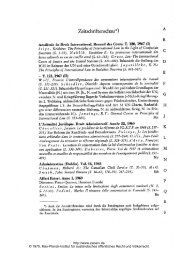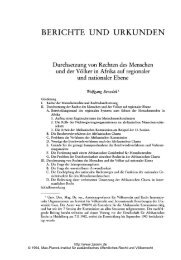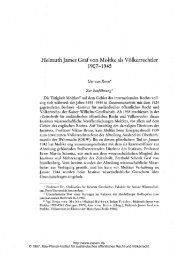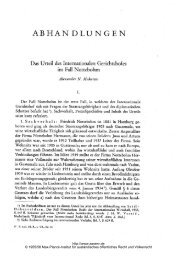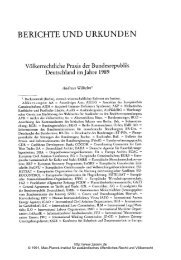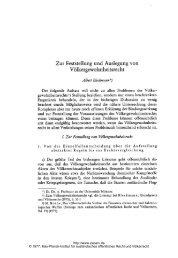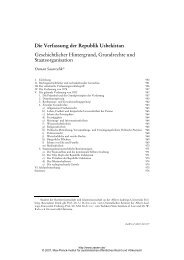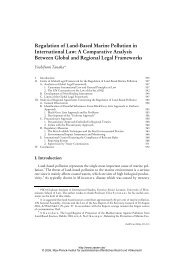The Law-Making of the International Telecommunication Union (ITU ...
The Law-Making of the International Telecommunication Union (ITU ...
The Law-Making of the International Telecommunication Union (ITU ...
Create successful ePaper yourself
Turn your PDF publications into a flip-book with our unique Google optimized e-Paper software.
492 Hinricher<br />
Conference, and, where appropriate, <strong>of</strong> <strong>the</strong> decisions <strong>of</strong> o<strong>the</strong>r conferences and<br />
meetings <strong>of</strong> <strong>the</strong> <strong>Union</strong>.23<br />
World conferences on international telecommunications may partially, or in ex-<br />
ceptional cases, completely revise <strong>the</strong> <strong>International</strong> <strong>Telecommunication</strong> Regula-<br />
tions and may deal with any question <strong>of</strong> a world-wide character within its Competence<br />
and related to its agenda .24 <strong>The</strong> conferences can fur<strong>the</strong>r adopt resolutions and<br />
decisions. 25<br />
<strong>The</strong> specialised agencies <strong>of</strong> <strong>the</strong> UN, including <strong>the</strong> <strong>ITU</strong>, have been sald to be<br />
quite productive and effective when it comes to law making and compliance with<br />
<strong>the</strong>se laws 26<br />
- even more than <strong>the</strong> United Nations in general.<br />
Within <strong>the</strong> complex<br />
- structure <strong>of</strong> <strong>the</strong> <strong>ITU</strong>, lawmaking takes on a variety <strong>of</strong> different forms all dealing<br />
exclusively with international telecommunications. According to Article 4 CS, <strong>the</strong><br />
legal framework <strong>of</strong> <strong>the</strong> <strong>ITU</strong>, <strong>the</strong> Constitution and Convention <strong>of</strong> <strong>the</strong><br />
<strong>International</strong> <strong>Telecommunication</strong> <strong>Union</strong>, have treaty status and are<br />
binding on <strong>ITU</strong> Member States.27 <strong>The</strong>se are complemented by <strong>the</strong> A d m 1 n i s t r a -<br />
tive Regulations (Radio Regulations and <strong>International</strong> Tele-<br />
communication Regulations), which are binding on its members, too, ac-<br />
cording to Article 4 (3). Article 6 (1) CS limits <strong>the</strong> binding force <strong>of</strong> <strong>the</strong> Constitution,<br />
<strong>the</strong> Convention and <strong>the</strong> Regulations. It states that "Member States are bound<br />
to abide by <strong>the</strong> provisions <strong>of</strong> this Constitution, <strong>the</strong> Convention and <strong>the</strong> Adminis-<br />
trative Regulations in all telecommunication <strong>of</strong>fices and stations which engage<br />
harmful interference<br />
in i n t e r n a t i o n a 1 services or which are capable <strong>of</strong> causing<br />
to radio services <strong>of</strong> o t h e r c o u n t r 1 e s '-'<br />
[emphasis addedl. Yet, it can never<strong>the</strong>less<br />
be argued that whatever 1s decided in <strong>the</strong> field <strong>of</strong> telecommunication on <strong>the</strong> inter-<br />
national plane might<br />
- Voting generally takes place<br />
also show effects on a national or even local basiS.28<br />
in <strong>the</strong> form <strong>of</strong> 'one state one<br />
ments to <strong>the</strong> Constitution requiring a two-thirds majority<br />
vote-"29 with amend-<br />
and amendments to <strong>the</strong><br />
Convention requiring a majority <strong>of</strong> at least half <strong>of</strong> <strong>the</strong> delegates at a Plenipotentiary<br />
Conference. 30<br />
Any amendments to <strong>the</strong> Constitution adopted at a plenipotentlary conference<br />
enter into force at a date fixed by <strong>the</strong> conference between those member states that<br />
have deposited before that date <strong>the</strong>ir instrument <strong>of</strong> ratification, acceptance or ap-<br />
24 Art. 25 (1) CS.<br />
25 Art. 25 (2) CS.<br />
26 White, <strong>The</strong> World Court, <strong>the</strong> WHO, and <strong>the</strong> UN System, in: Schermers/Blokker (eds.), <strong>The</strong><br />
Proliferation <strong>of</strong> international Organizations: Legal Issues, <strong>The</strong> Hague 2000, 98.<br />
27 In order for any decision to be binding, no matter what name is given to it, regulation, resolution<br />
or recommendation etc., a provision for such bindig effect is needed in <strong>the</strong> constitutive document;<br />
cf. Detter, <strong>The</strong> Effect <strong>of</strong> Resolutions <strong>of</strong> <strong>International</strong> Organizations, in: Makarczyk (ed.),<br />
<strong>The</strong>ory <strong>of</strong> <strong>International</strong> <strong>Law</strong> at <strong>the</strong> Threshold <strong>of</strong> <strong>the</strong> 211t Century -<br />
Skubiszewski, <strong>The</strong> Hague 1996, 385.<br />
Essays in Honour <strong>of</strong> Krzyszt<strong>of</strong><br />
28 Lyall, Posts and <strong>Telecommunication</strong>s, in: Schachterjoyner (eds.), United Nations Legal Order,<br />
Vol. 2, Cambridge 1995, 789.<br />
29 Art. 3 (2) lit. b & c CS; Art. 32 A CV.<br />
30 Art. 55 (4) CS and Art. 42 (4) CV, respectively.<br />
ZaöRV 64 (2004)<br />
http://www.zaoerv.de<br />
© 2004, Max-Planck-Institut für ausländisches öffentliches Recht und Völkerrecht


